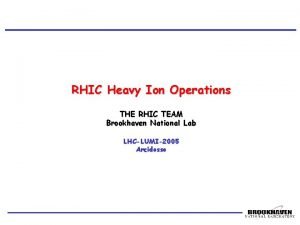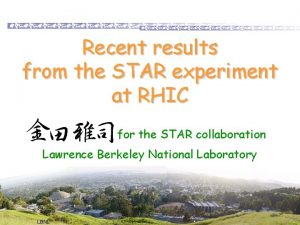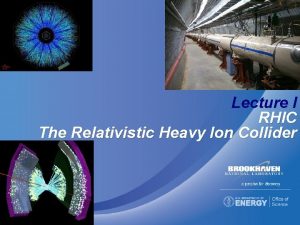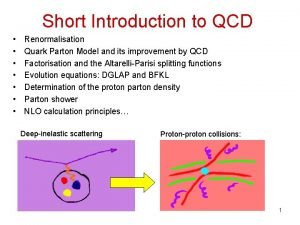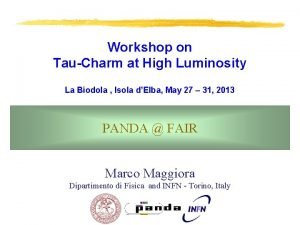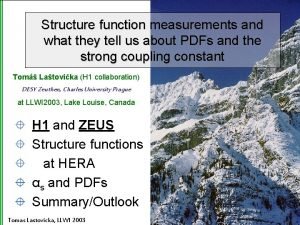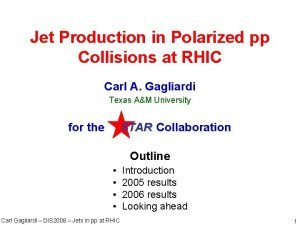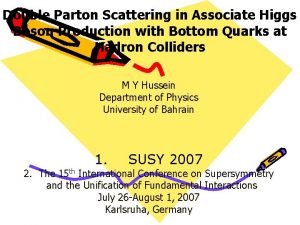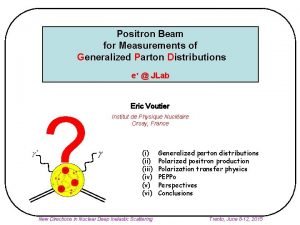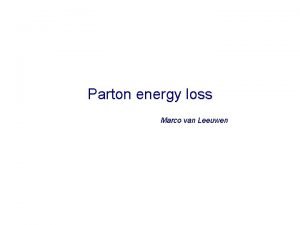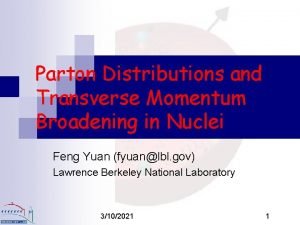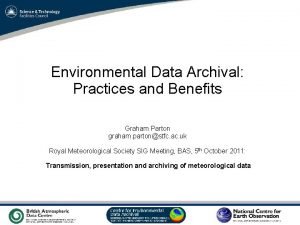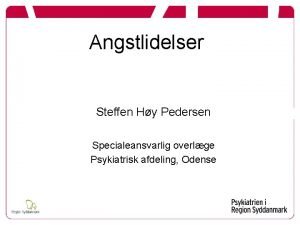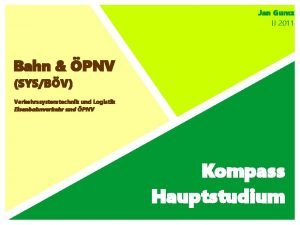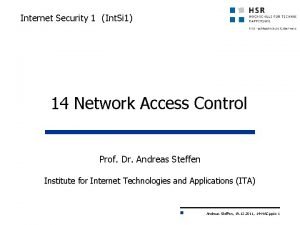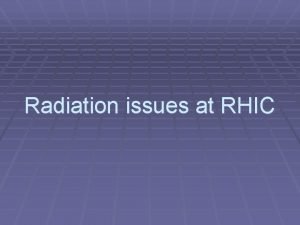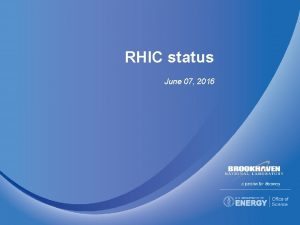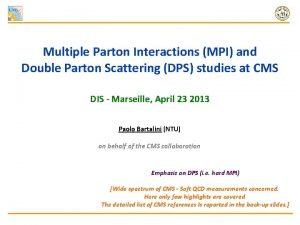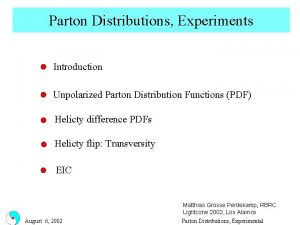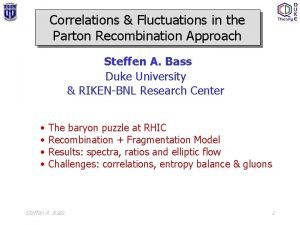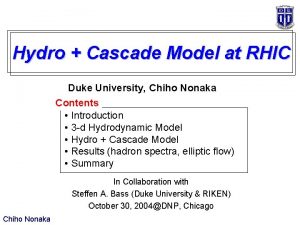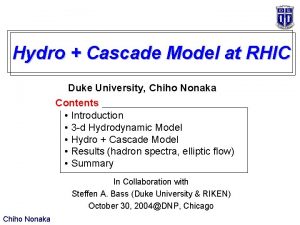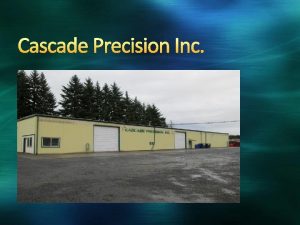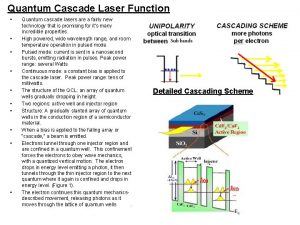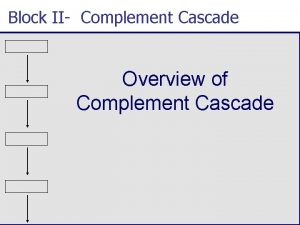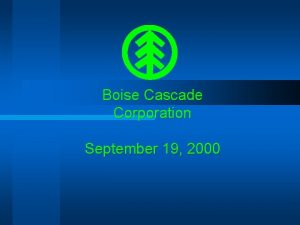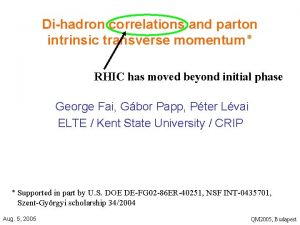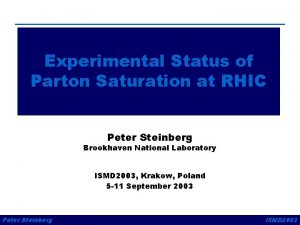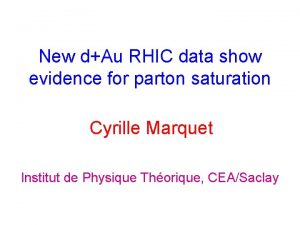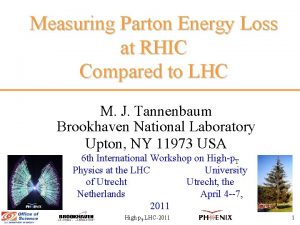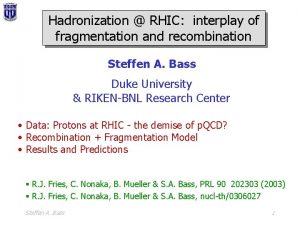RHIC Physics with the Parton Cascade Model Steffen






















- Slides: 22

RHIC Physics with the Parton Cascade Model Steffen A. Bass, Berndt Mueller, Dinesh K. Srivastava Duke University RIKEN BNL Research Center VECC Calcutta • The PCM: fundamentals & implementation • Applications: stopping @ RHIC and direct photons • Outlook & plans for the future Bass, Mueller, Srivastava 1

The PCM Model: current status results since QM’ 02: • Parton Rescattering and Screening in Au+Au at RHIC - Phys. Lett. B 551 (2003) 277 • Light from cascading partons in relativistic heavy-ion collisions - Phys. Rev. Lett. 90 (2003) 082301 • Semi-hard scattering of partons at SPS and RHIC : a study in contrast - Phys. Rev. C 66 (2002) 061902 Rapid Communication • Net baryon density in Au+Au collisions at the Relativistic Heavy Ion Collider - Phys. Rev. Lett. 91 (2003) 052302 • Transverse momentum distribution of net baryon number at RHIC - Journal of Physics G 29 (2003) L 51 -L 58 Bass, Mueller, Srivastava 2

Basic Principles of the PCM • degrees of freedom: quarks and gluons • classical trajectories in phase space (with relativistic kinematics) • initial state constructed from experimentally measured nucleon structure functions and elastic form factors • an interaction takes place if at the time of closest approach dmin of two partons • system evolves through a sequence of binary (2 2) elastic and inelastic scatterings of partons and initial and final state radiations within a leading-logarithmic approximation (2 N) • binary cross sections are calculated in leading order p. QCD with either a momentum cut-off or Debye screening to regularize IR behaviour • guiding scales: initialization scale Q 0, p. T cut-off p 0 / Debye-mass μD, intrinsic k. T, virtuality > μ 0 Bass, Mueller, Srivastava 3

Limitations of the PCM Approach Fundamental Limitations: • lack of coherence of initial state • range of validity of the Boltzmann Equation • interference effects are included only schematically • hadronization has to be modeled in an ad-hoc fashion • restriction to perturbative physics! Limitations of present implementation (as of Dec 2003) • lack of detailed balance: (no N 2 processes) • lack of selfconsistent medium corrections (screening) • heavy quarks? Bass, Mueller, Srivastava 4

Initial State: Parton Momenta • flavor and x are sampled from PDFs at an initial scale Q 0 and low x cut-off xmin • initial kt is sampled from a Gaussian of width Q 0 in case of no initial state radiation • virtualities are determined by: Bass, Mueller, Srivastava 5

Parton-Parton Scattering Cross-Sections gg gg q q’ q g q qbar q’ qbar’ g g q qbar q g q γ qq qq q qbar g γ q qbar γ γ q qbar g g • a common factor of παs 2(Q 2)/s 2 etc. • further decomposition according to color flow Bass, Mueller, Srivastava 6

Initial and final state radiation Probability for a branching is given in terms of the Sudakov form factors: space-like branchings: time-like branchings: • Altarelli-Parisi splitting functions included: Pq qg , Pg gg , Pg qqbar & Pq qγ Bass, Mueller, Srivastava 7

Hadronization • requires modeling & parameters beyond the PCM p. QCD framework • microscopic theory of hadronization needs yet to be established • phenomenological recombination + fragmentation approach may provide insight into hadronization dynamics • avoid hadronization by focusing on: Ø direct photons Ø net-baryons Bass, Mueller, Srivastava 8

Model Parameters • momentum cut-off p 0 Bass, Mueller, Srivastava 9

Debye Screening in the PCM • the Debye screening mass μD can be calculated in the one-loop approximation [Biro, Mueller & Wang: PLB 283 (1992) 171]: • PCM input are the (time-dependent) parton phase-space distributions F(p) • Note: ideally a local and time-dependent μD should be used to selfconsistently calculate the parton scattering cross sections Øcurrently beyond the scope of the numerical implementation of the PCM Bass, Mueller, Srivastava 10

Choice of p. Tmin: Screening Mass as Indicator • screening mass μD is calculated in one-loop approximation • time-evolution of μD reflects dynamics of collision: varies by factor of 2! • model self-consistency demands p. Tmin> μD : Ølower boundary for p. Tmin : approx. 0. 8 Ge. V Bass, Mueller, Srivastava 11

Baryon stopping at RHIC • influence of initial state • parton rescattering • temporal evolution Bass, Mueller, Srivastava 12

Baryon stopping at RHIC: Initial or Final State Effect? • net-baryon contribution from initial state (structure functions) is non-zero, even at midrapidity! Øinitial state alone accounts for d. Nnet-baryon/dy 5 • is the PCM capable of filling up mid-rapidity region? • is the baryon number transported or released at similar x? Bass, Mueller, Srivastava 13

Baryon stopping at RHIC: PCM Results • primary-primary scattering releases baryon-number at corresponding y • multiple rescattering & fragmentation fill up mid-rapidity domain Øinitial state & parton cascading can fully account for data! Bass, Mueller, Srivastava 14

pt dependence of net-quark dynamics • slope of net-quark pt distribution shows rapidity dependence • net-quark distributions freeze out earlier in the fragmentation regions than at y. CM Ø forward/backward rapidities sensitive to initial state / CGC? Bass, Mueller, Srivastava 15

Direct Photons • spectra and mass dependence • production times & dynamics • comparision: RHIC vs. SPS Bass, Mueller, Srivastava 16

Photon Production in the PCM relevant processes: • Compton: q g q γ • annihilation: q qbar g γ • bremsstrahlung: q* q γ Øphoton yield very sensitive to parton-parton rescattering Bass, Mueller, Srivastava 17

What can we learn from photons? • primary-primary collision contribution to yield is < 10% • emission duration of preequilibrium phase: ~ 0. 5 fm/c Bass, Mueller, Srivastava • photon yield directly proportional to the # of hard collisions Ø photon yield scales with Npart 4/3 18

Photon Production at SPS • at SPS, effects of parton rescattering can be observed via direct photons Øincluding intrinsic k. T, the PCM can account for measured photon yield Bass, Mueller, Srivastava 19

SPS vs. RHIC: a study in contrast SPS cut-off ptmin (Ge. V) # of hard collisions # of fragmentations av. Q 2 (Ge. V 2) 0. 7 RHIC 1. 0 255. 0 3618. 0 17. 0 2229. 0 0. 8 1. 7 • perturbative processes at SPS are negligible av. (Ge. V) 2. 6 4. 7 for overall reaction dynamics • sizable contribution at RHIC, factor 14 increase compared to SPS Bass, Mueller, Srivastava 20

Summary and Outlook Baryon Stopping: • initial state + PCM are compatible with the measured net-baryon density • no need for exotic and/or non-perturbative mechanisms • initial state contributes 30%, parton scattering 70% to d. N/dy • forward/backward rapidities may be sensitive to initial parton distribution Direct Photons: • strong sensitivity to parton rescattering • short emission duration in pre-equilibrium phase Outlook: • inclusion of gluon-fusion processes: analysis of thermalization • investigation of the microscopic dynamics of jet-quenching • heavy quark production: predictions for charm and bottom • hadronization: develop concepts and implementation Bass, Mueller, Srivastava 21

The End Bass, Mueller, Srivastava 22
 Rhic brookhaven
Rhic brookhaven Rhic ags users meeting 2020
Rhic ags users meeting 2020 Rhic
Rhic Orbital revolution
Orbital revolution Quark parton model
Quark parton model Parton distribution functions
Parton distribution functions Parton distribution functions
Parton distribution functions Parton distribution functions
Parton distribution functions Isabelle boulay dolly parton
Isabelle boulay dolly parton Double parton scattering
Double parton scattering Parton
Parton Parton
Parton Parton
Parton Dolly parton and mick jagger
Dolly parton and mick jagger Bonpatron developers
Bonpatron developers Graham parton
Graham parton Steffen döbert
Steffen döbert Steffen høy pedersen
Steffen høy pedersen Steffen rendle
Steffen rendle Steffen dutsch
Steffen dutsch Steffen
Steffen Mitarbeiterumfrage personalentwicklung
Mitarbeiterumfrage personalentwicklung Steffen schaack
Steffen schaack
